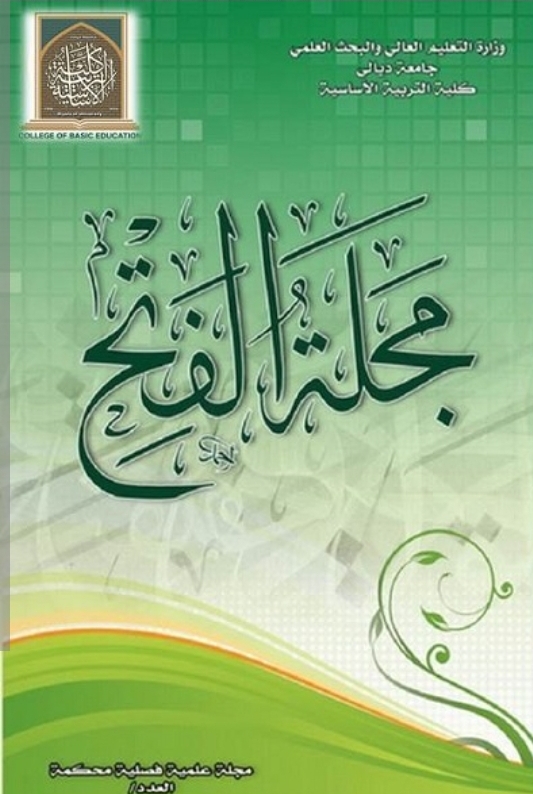اثر التعليم المدمج في تحصيل الطلبة في مادة الاستيعاب
DOI:
https://doi.org/10.23813/FA/27/3/22الكلمات المفتاحية:
: التعلم المدمج ,التحصيلالملخص
هدفت الدراسة الحالية الى الاجابة على ما أثر استخدام التعليم الممدمج لطلبة المرحلة الثانية في الاستيعاب. وتألفت عينة الدراسة من (30) طالبا من المرحلة الثانية في قسم اللغة الانكليزية بكلية التربية الأساسية في جامعة ديالى, تم توزيعهم الى مجموعتين: المجموعة التجريبية وتم تدريس مادة الاستيعاب باستخدام التعليم المدمج, وتضم (15) طالبا, والمجموعة الضابطة وتم تدريس مادة الاستيعاب بالطريقة المعتادة السائدة, وتضم (15) طالبا وقامت الباحثة بقياس تحصيل الاستيعاب القرائي كاداة رئيسية للبحث, وتم التحقق من صدقه وثباته, كما تم تحليل البيانات باستخدام تحليل التباين المصاحب(ANCOVA) وأظهرت نتائج التحليل الإحصائي وجود فروق ذات دلالة إحصائية في الاستيعاب في الاختبار البعدي لأفراد عينة الدراسة, إذ أن هناك أثراً لاستخدام التعليم المدمج في اختبار الاستيعاب لدى الطلبة الذين تم استخدام التعليم المدمج معهم
المراجع
Azizan, F.Z. (2010). Blended Learning in Higher Education Institution in Malaysia. Proceedings of Regional Conference on Knowledge Integration in ICT.
-Blended Learning (Staker / Horn - May 2012)" (PDF). Retrieved 2013-10-24. Chen, C.C., & Jones, K.T. (2007). “Blended Learning vs. Traditional Classroom Settings:Assessing Effectiveness and Student Perceptions in an MBA Accounting Course”. The Journal of Educators Online, 4 (1).
Davis, H.C. and Fill, K. (2007). "Embedding blended learning in a university's teaching culture: Experiences and reflections" .British Journal of Educational Technology, 38(5).
Delialioglu, O., and Yildirim, Z. (2007)."Students' Perceptions on Effective Dimensions of Interactive Learning in a Blended Learning Environment" .Education Technology and Society, 10 (2), 133-146.
Driscoll, M.(2002,March 1,2002).Blended Learning: Let's get beyond the hype. e- learning,54.
Ginns, P. and Ellis, R.A. (2009). "Evaluating the quality of e-learning at the degree level in the student experience of blended learning" . British Journal of Educational Technology, 40(4), Pages:652-663.
Hameed, Sh., Badii, A., & Cullen, A.J. (2008). “Effective E-Learning Integration with Traditional Learning in a Blended Learning Environment”. European and Mediterranean Conference on Information Systems.
Hassan Zabon; a new vision in e-learning, issues-application-evaluation, Riyadh: (Al-Dar Al-suleya for education, 2005).
Harrington, A. M. (2010). “Problematizing the Hybrid Classroom for ESL/EFL Students”. TESL-EJ 14 (3).
Mohammed Mahmoud al-Hilla; teaching methods and strategies, Vol.3: (United Arab Emirates, Al Ain, University Book House, 2003).
Oh, E., & Park, S. (2009). “How are universities involved in blended instruction?”Educational Technology & Society, 12 (3).
Saunders, William M. and Goldenberg, Claude (1999)," The effect of instructional conversation and literature logs on limited and fluent English students, story comprehension and thematic understanding". The Elementary School Journal, V.99, N.4
Uddestou. P. and Nwin, L. Teaching and Learning in Further Education Rutledy: (1997)
Usta, E., & Özdemir, S.M. (2007). “An Analysis of Students' Opinions about Blended
Learning Environment”. Retrieved from: http://eric.ed.gov.
Wang, M. J. (2010). "Online collaboration and offline interaction between students using asynchronous tools in blended learning". Australasian Journal of Educational Technology, 26(6), 830-846.
التنزيلات
منشور
كيفية الاقتباس
إصدار
القسم
الرخصة
الحقوق الفكرية (c) 2023 مجلة الفتح للبحوث التربوية والنفسية

هذا العمل مرخص بموجب Creative Commons Attribution 4.0 International License.
حقوق النشر والترخيص
تطبق مجلة الفتح للبحوث التربوية والنفسية ترخيص CC BY (ترخيص Creative Commons Attribution 4.0 International). يسمح هذا الترخيص للمؤلفين بالاحتفاظ بملكية حقوق الطبع والنشر لأوراقهم. لكن هذا الترخيص يسمح لأي مستخدم بتنزيل المقالة وطباعتها واستخراجها وإعادة استخدامها وأرشفتها وتوزيعها ، طالما تم منح الائتمان المناسب للمؤلفين ومصدر العمل. يضمن الترخيص أن المقالة ستكون متاحة على نطاق واسع بقدر الإمكان وأن المقالة يمكن تضمينها في أي أرشيف علمي.
لمزيد من المعلومات، يرجى متابعة الرابط: https://creativecommons.org/licenses/by/4.0/.



